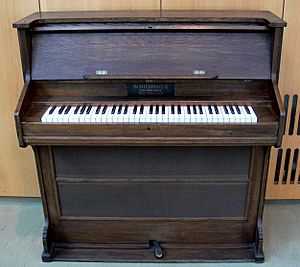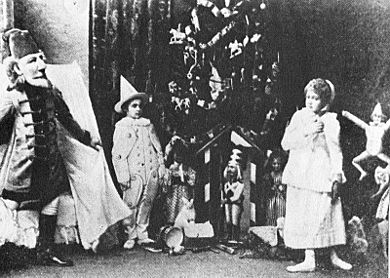The Nutcracker facts for kids
Quick facts for kids The Nutcracker |
|
|---|---|

Tchaikovsky in 1892
|
|
| Choreographed by | Marius Petipa Lev Ivanov |
| Composed by | Pyotr Ilyich Tchaikovsky |
| Libretto by | Ivan Vsevolozhsky Marius Petipa |
| Based on | E.T.A. Hoffmann's "The Nutcracker and the Mouse King" |
| Date of premiere | 18 December 1892 |
| Place of premiere | Mariinsky Theatre St. Petersburg |
| Original ballet company | Mariinsky Ballet |
| Characters | Clara Drosselmeyer Nutcracker Prince Mouse King Sugar Plum Fairy |
| Designs by | M. I. Botcharov K. M. Ivanov Ivan Vsevolozhsky |
| Setting | Act 1: Christmas Eve in 19th century Germany Act 2: The Land of Sweets |
| Genre | Fairy tale |
| Type | Classical ballet |
The Nutcracker is a famous classical ballet with two acts. It is based on a fairy tale from 1816 called The Nutcracker and the Mouse King by E.T.A. Hoffmann. The story is about a young girl who travels to the magical Land of Sweets on Christmas Eve.
Ivan Vsevolozhsky and Marius Petipa changed Hoffmann's story for the ballet. Pyotr Ilyich Tchaikovsky wrote the beautiful music. Marius Petipa and Lev Ivanov created the dances. The Nutcracker was first shown at the Mariinsky Theatre in St. Petersburg, Russia, on December 18, 1892. It was not a huge hit at first.
Later, in 1940, Walt Disney used some of the Nutcracker music in his animated movie Fantasia. This made people more interested in the ballet. Its popularity grew even more when George Balanchine's The Nutcracker was shown on television in the late 1950s. Since then, the ballet has been performed in many places around the world. Before the ballet's first show, Tchaikovsky created the Nutcracker Suite from some of its music. This suite was very successful and is still played today.
Contents
How The Nutcracker Ballet Began

The idea for The Nutcracker came from the success of another ballet, The Sleeping Beauty. That ballet was performed in St. Petersburg, Russia, in 1890. It was created by Ivan Vsevolozhsky, the director of the Imperial Theatres, along with the composer Tchaikovsky and the choreographer Marius Petipa. Vsevolozsky believed another ballet based on a children's story would be just as popular.
He chose Hoffmann's 1816 fairy tale "The Nutcracker and the Mouse King" for the new ballet. Russians already loved this story. Vsevolozsky wrote his own version of Hoffmann's story. He based it on a translation by Alexandre Dumas and removed many parts of the original. Petipa then changed Vsevolozsky's story to fit the needs of a ballet. Vsevolozsky then convinced Tchaikovsky to write the music. Tchaikovsky did not like the story very much, but he agreed to compose the music.
Petipa planned the dances. He gave Tchaikovsky specific instructions for the music. For example, he wanted a huge crescendo (music getting louder) with 48 bars as the Christmas tree grew taller in Act 1. He also asked that the music for the "Dance of the Sugar Plum Fairy" sound like water drops splashing in a fountain.
By March 1892, the music was almost finished. Tchaikovsky took the "Dance of the Sugar Plum Fairy", the "Waltz of the Flowers", and other parts to create the 20-minute Nutcracker Suite. It was first played for the Russian Musical Society, and they loved it. The Nutcracker Suite is still very popular today.
Tchaikovsky finished the ballet's music in April 1892. Rehearsals began in September 1892. Petipa became sick, so his assistant Lev Ivanov finished creating the dances. The ballet first opened on December 18, 1892, at the Mariinsky Theatre in St. Petersburg. Tchaikovsky's one-act opera Iolanta was performed before The Nutcracker. The ballet ran for eleven shows and ended in 1893.
The Nutcracker's Journey: From Russia to the World
In 1919, a choreographer named Alexander Gorsky created a new version. He removed the Sugar Plum Fairy and her Cavalier. Instead, he gave their dances to Clara and the Nutcracker Prince. These roles were now played by adults, not children. A shorter version of the ballet was first performed outside Russia in Budapest in 1927.
In 1934, Vasili Vainonen of the Kirov Ballet also staged a version. He too used adult dancers for Clara and the Prince, like Gorsky. Vainonen's version influenced many later productions. Knowledge of the dances spread as many dancers moved to the west after the Russian Revolution.
The first full performance outside Russia happened in England in 1934. Nicholas Sergeyev staged it at the Vic-Wells Ballet. This version used some of Petipa's original dances. Since 1952, the ballet has been performed there every year.
In 1944, the Nutcracker was staged at the San Francisco Ballet by William Christensen. This was the very first full-length performance in America on Christmas Eve. Christensen, born in Utah, was called the grandfather of American Ballet. He founded the San Francisco Ballet in 1938. Later, he started the first ballet department at the University of Utah in 1951 and Ballet West in 1963. His version celebrated its 75th Anniversary in 2019-2020.
In 1954, George Balanchine staged The Nutcracker in New York City. People really enjoyed it. When it was shown on television in 1957 and 1958, the ballet became more famous than ever. Balanchine's TV Nutcracker was fun for new viewers and still pleased ballet fans. In the 1960s, smaller ballet companies started performing The Nutcracker. It helped them earn money and stay in business.
The Story of The Nutcracker
The ballet's story takes place in Germany in the early 1800s. The first act begins on Christmas Eve at the Silberhaus family's party. Guests arrive, and children receive their presents. They dance happily around the room.
Suddenly, a mysterious toy-maker named Drosselmeyer enters. He is Clara Silberhaus's godfather. He brings four dancing dolls for the children. He also has a special surprise for Clara: a nutcracker. Clara loves it, but her brother Fritz accidentally breaks it. Clara gently puts the Nutcracker in her doll bed to rest.
The party ends, and everyone goes to bed. Clara quietly sneaks back to the room. She wants to make sure her Nutcracker is safe. All at once, mice start scurrying around the room. The dolls, tin soldiers, and other toys come to life to fight the mice.
The Christmas tree grows taller and taller. The Nutcracker jumps from the doll bed to fight the Mouse King. When the Nutcracker is in danger, Clara saves him. She throws her slipper at the Mouse King. The Mouse King and all the other mice run away.
The Nutcracker then turns into a human prince. Clara and the Nutcracker Prince travel through snowy woods to the magical Land of Sweets. The beautiful Sugar Plum Fairy rules this land. She welcomes the two children and asks her subjects to dance for them. There are dances about Coffee, Tea, and Chocolate, along with many others. The ballet ends with everyone dancing a waltz.
The Music of The Nutcracker
Instruments in the Orchestra
Tchaikovsky wrote The Nutcracker for a full orchestra. It includes strings, woodwinds, brass, and percussion. He also added a celesta for the "Dance of the Sugar Plum Fairy" in Act 2. For the Christmas party in Act 1, he used children's instruments. These included drums, trumpets, cymbals, bird calls, whistles, and a rattle.
These instruments were specially ordered and tuned for Tchaikovsky. The rattle is heard when Fritz cracks nuts in Act 1. The other children's instruments are heard when the boys make noise while Clara comforts the broken Nutcracker.
Tchaikovsky hoped the children would play the instruments on stage. However, they found it hard to stay in time with the orchestra. Because of this, Tchaikovsky decided they could play freely. He did not make them follow the written music exactly. After the first night, Tchaikovsky sent thanks and sweets to the children of the Imperial Ballet School.
The Sugar Plum Fairy
The Sugar Plum Fairy is an important character in The Nutcracker. She only dances in Act 2 of the ballet. Some people think the second act is Clara's dream. Others believe it is a real place created by Drosselmeyer. The Sugar Plum Fairy is the ruler of the Land of Sweets. She welcomes the Nutcracker Prince and Clara to her land. She then orders many dances to entertain them. A prima ballerina (main dancer) usually plays this role. She does not have a lot of dancing to do by herself. She performs a pas de deux (a dance for two) with a male dancer near the end of the ballet. Her part in this dance is called "Dance of the Sugar Plum Fairy."
The Famous Dance of the Sugar Plum Fairy
The "Dance of the Sugar Plum Fairy" is one of the most well-known parts of The Nutcracker. It was written for the celesta. This instrument was very new when the dance was created. It looks like a small piano but sounds like bells. Tchaikovsky found the celesta in Paris in 1891. His publisher bought one and promised to keep it a secret. Tchaikovsky did not want other composers like Rimsky-Korsakov or Glazunov to use it before him. Petipa wanted the Sugar Plum Fairy's music to sound like water drops splashing in a fountain. Tchaikovsky thought the celesta was perfect for this sound. The original dance steps for this part are not known today. Antonietta Dell'Era was the first dancer to play the Sugar Plum Fairy. Because the character had little dancing, Dell'Era added a gavotte (a type of dance) by Alphonse Czibulka to her performance. This gave her more to do.
Modern Performances of The Nutcracker
Today, The Nutcracker is performed and seen by many people worldwide. Jennifer Fisher says it is "the most popular and most often [staged] ballet in the world." In North America, it is a yearly tradition in many places. Parents and children often help stage the ballet and dance in it. Professional ballerinas dance alongside children who are just learning. Parents work on costumes and sets. Local celebrities sometimes take small, non-dancing roles.
There have been many different versions of the ballet over the years. In the United States, for example, there are hula, tap dance, reggae, wheelchair, dance-along, ice, and drag versions. In Canada, there have even been hockey adaptations. Products like Nutcracker dolls, soaps, foods, and clothing are sold at theaters before the show.
Some ballet fans worry that The Nutcracker is being made too simple for everyone. The reasons the ballet was not liked in Russia at first (many child dancers, a confusing story) seem to be why it is so popular in North America now. Americans enjoy seeing their children on stage. The story is also similar to "rags-to-riches" tales that Americans love. However, some people complain about the stereotypes of children in Act 1 (boys are naughty, girls are nice). They also mention stereotypes of Arabians and Chinese people in Act 2.
Images for kids
See also
 In Spanish: El cascanueces para niños
In Spanish: El cascanueces para niños








